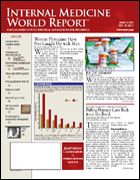Novel Therapy a Promising New Option for Osteoporosis
Novel Therapy a Promising New Option for Osteoporosis
an estimated 44 million American women and men aged ≥50 years are at risk of breaking a bone as a result of osteoporosis or low bone mass, yet many patients and even physicians lack knowledge about the disease, and screening for those at risk is far from standard practice.
In 2002, the FDA approved teriparatide (Forteo [rDNA origin]), or human parathyroid
hormone, for the treatment of osteoporosis in postmenopausal women at high risk of bone fracture. It also is approved for men with primary or hypogonadal osteoporosis who are at high risk of fracture. Teriparatide is the first in a new class of drugs called bone formation agents
that primarily stimulate new bone by increasing the number and action of boneforming
osteoblasts. The use of the drug is limited for a maximum of 2 years. Three groups of investigators recently looked at the use of human parathyroid hormone in combination with a bisphosphonate to determine if there are added benefits when the 2 agents are used
together. The first study (N Engl J Med. 2005;353:566- 575) included 126 women with osteoporosis who had been receiving alendronate (Fosamax) for ≥1 year and who were randomly
assigned to continued alendronate plus subcutaneous parathyroid hormone for three 3-month cycles alternating with 3- month periods without parathyroid hormone, or alendronate monotherapy for 15 months. Increases in bone formation indexes were seen in all women receiving parathyroid hormone; although bone formation decreases were noted among women
receiving cyclic parathyroid hormone during periods when the hormone was not taken, levels rose again when the hormone therapy was resumed. Increases in spinal bone mineral density (BMD) were also seen in women receiving daily and cyclic parathyroid hormone (6.1% and 5.4%,
respectively) compared with those receiving alendronate monotherapy (P <.01). The second study (N Engl J Med. 2005; 353:555-565) was an extension of a trial that had included women who received parathyroid hormone monotherapy (100 mg/d) for 1 year. They were randomly reassigned to 1 additional year with either placebo (n = 60)or alendronate (n = 59). Patients who had been taking combination therapy in the first year of the trial received alendronate in the second year; patients who had received alendronate monotherapy in year 1 continued
to receive alendronate in year 2. Dual-energy x-ray absorptiometry (DEXA) and
quantitative computed tomography (CT) were used to measure BMD at the spine
and hip. At the end of 2 years,increases in BMD were noted in patients receiving parathyroid therapy compared with those in the placebo group, most notably in trabecular bone at the spine on quantitative CT, where an increase of 31% was seen in the parathyroid-hormone-plusalendronate group versus the parathyroidhormone- plus-placebo group. In addition,
patients in the placebo group lost significant BMD during the second year of the trial.
The third trial (Arch Intern Med. 2005; 165:1762-1768) included 203 postmenopausal
women (aged 45-84 years) who had a BMD T-score between —2.5 and –4.0 at
either the lumbar spine or femoral neck. They were randomized to receive oncedaily
injections of teriparatide (20 mg/d) and oral placebo or oral alendronate (10
mg/d) and once-daily injectable placebo. The women also received daily calcium
supplements and vitamin D (1000 mg and 400-800 IU, respectively). Markers of bone turnover and areal BMD were assessed for all participants. Areal BMD was evaluated using a DEXA
scan of the lumbar spine at baseline and at 3, 6, 12, and 18 months and of the femoral
neck at baseline, 12, and 18 months. Volumetric BMD of the lumbar spine and
the femoral neck was assessed in a subset of 56 patients by quantitative CT at baseline
and at 6 and 18 months. Effects on BMD and bone turnover are shown in the Table.
“The main goal of a physician who treats a patient with osteoporosis is to
reduce the patient’s risk for suffering an osteoporotic fracture. Increasing BMD is
an important part of the process, but so is the method by which it’s improved,” said
Michael McClung, MD, lead investigator of the Archives study and founding director
of the Oregon Osteoporosis Center, Portland. “This study assesses these skeletal
changes through several measurements— BMD and markers of bone turnover—to give us a better understanding of how these skeletal changes occur.” In an accompaning editorial in the New England Journal of Medicine (2005;353: 624-625), Robert P. Heaney, MD, and
Robert R. Recker, MD, both of the Osteoporosis Research Center, Creighton University, Omaha, Neb, listed several conclusions that could be drawn about both treatments: • Both are effective as monotherapy • Using parathyroid hormone and a bisphosphonate as combination therapy
seems to boost central bone mass, but not as much as parathyroid hormone monotherapy
• If no additional treatment is used in the time following parathyroid hormone therapy, all or some of the bone gained during such treatment will be lost. Since not all patients respond in the
same way to all treatments, physicians need to keep asking themselves which treatment
is best for a particular patient, they stressed. Although these data are promising, they
added that important questions remain, such as “should patients with low initial
rates of bone remodeling receive a suppressorof bone remodeling, or would they be
better served by treatment with parathyroid hormone from the outset?”
